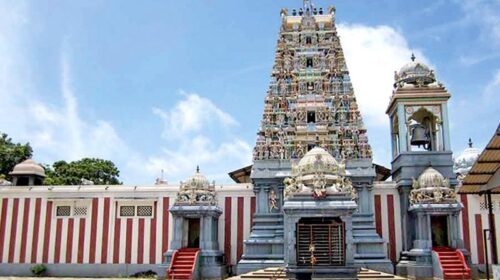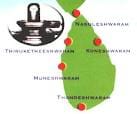The island is preparing new packages such as the Murugan-Shiva Shakthi trails
The Hindu
T. Ramakrishnanan
 Sri Lanka’s tourism officials, conscious of the dire need to shore up their country’s economy, plan to woo a greater number of Indian tourists, who constitute the single largest segment of foreign tourists, through new packages such as the Murugan-Shiva Shakthi trails. Their optimism stems from the fact that there is a proposal to resume air passenger services from the Palaly airport in Jaffna to destinations in the southern part of India.
Sri Lanka’s tourism officials, conscious of the dire need to shore up their country’s economy, plan to woo a greater number of Indian tourists, who constitute the single largest segment of foreign tourists, through new packages such as the Murugan-Shiva Shakthi trails. Their optimism stems from the fact that there is a proposal to resume air passenger services from the Palaly airport in Jaffna to destinations in the southern part of India.
As part of the Murugan trail, two important places — Nallur Kandaswamy or Murugan temple in Jaffna of the Northern Province, and Kataragama of the Uva Province in the southeast — have been included.
Referring to the ongoing 25-day-long festival in Nallur (which concludes on August 27), Chalaka Gajabahu, chairman of the Sri Lanka Tourism Promotion Bureau, told a group of journalists from India recently in Colombo that the festival was expected to draw over a million devotees, including 1,00,000 from the diaspora. A “special calendar” of events was being prepared for Hindu devotees.
Promoting the North
To a query whether the Northern Province would be a regular feature in the packages for tourists, Mr. Gajabahu replied in the affirmative and asserted “we have been actively promoting the North on trade FAMs [familiarisation trips].” The East too would receive more focus in view of its diverse cultural significance that encompassed Islam. However, he conceded that marketing of the North had not been done “much.”
Nagabhooshani Amman temple, Nainativu, Northern Province, Sri Lanka.
 The question was raised in the context of coverage of Naguleeswaram in Jaffna and Thiruketheeswaram in Mannar, both coming under five abodes of Lord Shiva in Sri Lanka, in the new Murugan trail. The other three abodes included Thirukoneeswaram temple, Trincomalee, in the Eastern Province, Munneeswaram temple in the north-west and Tondeeshwaram temple, near Matara, in the south. The trail would also include shrines such as Nagapooshani Amman temple and Nagadeepa Purana Vihara, both in Nainativu, off Jaffna.
The question was raised in the context of coverage of Naguleeswaram in Jaffna and Thiruketheeswaram in Mannar, both coming under five abodes of Lord Shiva in Sri Lanka, in the new Murugan trail. The other three abodes included Thirukoneeswaram temple, Trincomalee, in the Eastern Province, Munneeswaram temple in the north-west and Tondeeshwaram temple, near Matara, in the south. The trail would also include shrines such as Nagapooshani Amman temple and Nagadeepa Purana Vihara, both in Nainativu, off Jaffna.
Ramayana trail
Pointing out that a Ramayana trail had been in place for many years, the Bureau chief called for modification in the programme to accommodate a greater number of youth.
Even as Indian tourists formed the biggest chunk of foreign tourists, Mr. Gajabahu emphasised that various steps were being taken to attract them more. Adventure tourism, entertainment and gambling were some of the attractions being offered by Sri Lanka. His team had planned to visit Indian cities in September such as Mumbai and New Delhi for the purpose of promotion.
On the overall target for foreign tourists, the Bureau chief said they hope to attract 8.5 lakh to 10 lakh tourists (1 million) this year. However, the aim was to get back to the 2018 tally of 2.1 million, as the tourism sector had been hit badly following the 2019 Easter Sunday attacks and the COVID-19 pandemic. “For the next six months to one year, we want to create a positive picture about Sri Lanka. Refreshening, positioning and taking it forward will be our functions,” Mr. Gajabahu observed, adding that till July, about 4.5 lakh foreign tourists had arrived this year.
Welcoming the tourism authorities’ initiative, Selvaretnam Raghavan, president of the Thiruketheeswaram Temple Restoration Society, says the new trail will bring in more devotees to the temple too, which was consecrated on July 6. He adds that the temple, which was damaged during the civil war, was renovated at a total cost of LKR 900 million which included LKR 320 million from the Indian government.